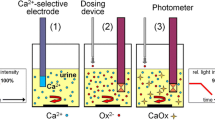Summary
The risk of calcium crystallization (CaOx-CR) in urine was analyzed by means of crystal counting following standardized addition of oxalate. CaOx-CR was determined in 24h urine samples from 21 stone formers and 26 normal subjects following dilution of urine to a creatinine concentration of 5 μmol per ml. The mean (±SD) CaOx-CR was in stone formers 1.42±0.57 and in normal subjects 1.29±0.40. CaOx-CR was also analyzed in 16 fresh urine samples diluted to 80 per cent of the original concentration whereby values between 0.36 and 3.6 were recorded. There was a good correlation between CaOx-CR and estimates of the ion-activity product of CaOx, both in urine diluted to 5 μmol of creatinine per ml and in 80 per cent diluted urine. It ist suggested that the method described is of value for evalution and follow up of patients with CaOx urolithiasis.
Similar content being viewed by others
References
Robertson WG, Scurr DS, Bridge CM (1980) Factors influencing the crystallization of calcium oxalate in urine — critique. J Cryst Growth 53:182–194
Burns JB, Finlayson B (1983) why some people have stone disease and others do not. In: Roth RA, Finlayson B (eds) Stones-clinical management of urolithiasis. Williams and Wilkins, Baltimore London, pp 3–7
Fleisch H (1978) Inhibitors and promoters of stone formation. Kidney Int 13:361–371
Robertson WG, Peacock M, Heyburn PJ, Marshall DH, Clark PB (1978) Risk factors in calcium stone disease of the urinary tract. Br J Urol 50:449–454
Finlayson B (1977) Calcium stones: some physical and clinical aspects. In: David DS (ed) Calcium metabolism in renal failure and nephrolithiasis. John Wiley and Sons, New York, pp 337–382
Gill WB, Silvert MA, Roma MJ (1974) Supersaturation levels and crystallization rates of calcium oxalate from urines of normal humans and stone formers determined by a 14C-oxalate technique. Invest Urol 12:203–209
Hallson PC, Rose GA (1978) A new urinary test for stone activity. Br J Urol 50:442–448
Ryall RL, Bagley CJ, Marshall VR (1981) Independent assessment of the growth and aggregation of calcium oxalate crystals using the coulter counter. Invest Urol 18:401–405
Tomazic B, Nancollas GH (1980) Crystal groth of calcium oxalate hydrates: a comparative kinetics study. J Coll Interface Sci 75:149–160
Doremus RH, Teich S, Silvis PX (1978) Crystallization of calcium oxalate from synthetic urine. Invest Urol 15:469–472
Nicar MJ, Hill K, Pak CYC (1983) A simple technique for assessing the propensity for crystallization of calcium oxalate and brushite in urine from the increment in oxalate or calcium necessary to elicit precipitation. Metabolism 22:906–910
Jacobson AL, Singhal PC, Mandin H, Hyne JB (1983) New methods to determine the state of saturation of urine and to discriminate between the urine of control subjects and stone formers. Clin Biochem 16:79–86
Tiselius H-G, Larsson L (1981) Biochemical evaluation of patients with urolithiasis. Eur Urol 7:31–34
Larsson L, Libert B, Asperud M (1982) Determination of urinary oxalate by reversed-phase ion-pair “high-performance” liquid chromatography. Clin Chem 28:2272–2274
Tiselius H-G (1982) An improved method for the routine biochemical evaluation of patients with recurrent calcium oxalate stone disease. Clin Chim Acta 122:409–418
Tiselius H-G, Larsson L (1985) Studies on urine composition in patients with calcium oxalate stone disease. In: Urolithiasis and related clinical research. Plenum Press, New York, pp 291–294
Ahlstrand C, Tiselius H-G, Larsson L (1984) Diurnal variation in urine composition during the day in patients with calcium oxalate stone disease. J Urol 131:77–81
Tiselius H-G, Fornander A-M (1981) Evaluation of a routine method for determination of calcium oxalate crystal growth inhibition in diluted urine samples. Clin Chem 27:565–568
Robertson WG, Peacock M, Marshall RW, Marshall DH, Nordin BEC (1976) Saturation — inhibition index as a measure of the risk of calcium oxalate stone formation in the urinary tract. N Eng J Med 5:249–252
Author information
Authors and Affiliations
Rights and permissions
About this article
Cite this article
Tiselius, HG. Measurement of the risk of calcium oxalate crystallization in urine. Urol. Res. 13, 297–300 (1985). https://doi.org/10.1007/BF00262660
Accepted:
Issue Date:
DOI: https://doi.org/10.1007/BF00262660




